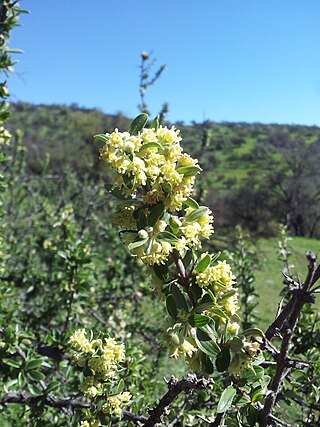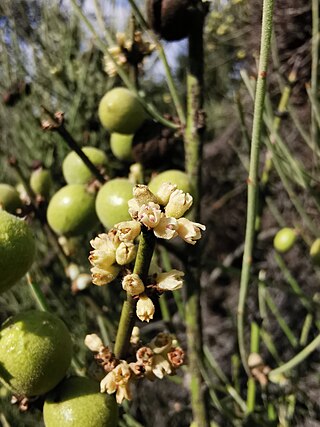
Lathyrus is a genus of flowering plants in the legume family Fabaceae, and contains approximately 160 species. Commonly known as peavines or vetchlings, they are native to temperate areas, with a breakdown of 52 species in Europe, 30 species in North America, 78 in Asia, 24 in tropical East Africa, and 24 in temperate South America. There are annual and perennial species which may be climbing or bushy. This genus has numerous sections, including Orobus, which was once a separate genus. The genus has numerous synonyms, including Pisum, the ancient Latin name for the pea.

Prosopis is a genus of flowering plants in the family Fabaceae. It contains around 45 species of spiny trees and shrubs found in subtropical and tropical regions of the Americas, Africa, Western Asia, and South Asia. They often thrive in arid soil and are resistant to drought, on occasion developing extremely deep root systems. Their wood is usually hard, dense and durable. Their fruits are pods and may contain large amounts of sugar. The generic name means "burdock" in late Latin and originated in the Greek language.

Dioscorea is a genus of over 600 species of flowering plants in the family Dioscoreaceae, native throughout the tropical and warm temperate regions of the world. The vast majority of the species are tropical, with only a few species extending into temperate climates. It was named by the monk Charles Plumier after the ancient Greek physician and botanist Dioscorides.

Calliandra is a genus of flowering plants in the pea family, Fabaceae, in the mimosoid clade of the subfamily Caesalpinioideae. It contains about 140 species that are native to tropical and subtropical regions of the Americas.

Azorella is a genus of flowering plants in the family Apiaceae, native to South America, New Zealand, southeastern Australia, and the islands of the Southern Ocean.

Calandrinia is a genus of flowering plants known as purslanes and redmaids. It includes 37 species of annual and perennial herbs which bear colorful flowers in shades of red to purple and white. Species of this genus are native to the Americas, including western and southern South America, Central America, and western North America. Some species have been introduced to parts of Australia, New Zealand, southern Africa, Asia, and Europe. Over 60 species native to Australia and New Guinea that were formerly included in Calandrinia are now placed in a separate genus, Rumicastrum or Parakeelya. A single eastern Australian species named in 2022, Calandrinia petrophila, is still included in Calandrinia, but will be placed into the Australian genus when the name of the new genus is finally settled.

Iresine is a genus of flowering plants in the family Amaranthaceae. It contains 20 to 25 species, all of which are native to the American tropics. The generic name is derived from the Greek word εριος (erios), meaning "wooly", referring to the trichome-covered flowers. Bloodleaf is a common name for those species that have colored foliage, and these are often cultivated as ornamental plants. Some species are additives to versions of the hallucinogenic drink ayahuasca.

Loasa is a genus of flowering plants in the family Loasaceae. The genus contains about 100 species native to Central and South America. Species of Loasa are prickly herbs or shrubs that have nettle-like stinging hairs. Some species of Loasa are grown as ornamental plants and are known as Chile nettle. Its flowers have five yellow petals covering united stamens and distinctive large coloured nectaries. Caiophora is a closely related genus that also has stinging hairs and is found on rocky slopes of the Andes.

Trevoa is a genus of actinorhizal plants; these dicotyledon flora are trees or small shrubs. The genus was first proposed by Miers in 1825, but was not fully described until 1830 by Sir William Jackson Hooker. Genus members are notable for their ability to fix nitrogen. Species of this genus are generally found in the near coastal forests and arid shrubland of South America. Some species are localized in the mountains of central Chile; for example, the species Trevoa trinervis occurs in the La Campana National Park and other proximate areas of central Chile.

Adesmia is a genus of flowering plants in the legume family, Fabaceae. It was recently assigned to the informal monophyletic Adesmia clade within the Dalbergieae.

Lumnitzera is an Indo-West Pacific mangrove genus in the family Combretaceae. An English common name is black mangrove. Lumnitzera, named after the German botanist, Stephan Lumnitzer (1750-1806), occurs in mangroves from East Africa to the Western Pacific, and northern Australia.

Guettardeae is a tribe of flowering plants in the family Rubiaceae and contains about 748 species in 14 genera. Its representatives are widespread geographically and are found in the tropics and subtropics.

Scutia is a genus of flowering plants in the family Rhamnaceae, native to the Galápagos, South America, Africa, Madagascar, the Mascarene Islands, the Indian subcontinent, Sri Lanka, southern China and Southeast Asia. They are shrubs or small trees.

Homalocarpus is a genus of flowering plants in the family Apiaceae, found in Chile. They are annual herbs with white, yellow, red or purple flowers.

Retanilla is a genus of flowering plants in the family Rhamnaceae, native to Chile, Peru, and Argentina. The species in this genus are actinorhizal plants.
Tapeinostemon is a genus of flowering plants in the family Gentianaceae, native to northern South America. It has microreticulate pollen grains, supporting its placement in the tribe Saccifolieae.
Montiopsis is a genus of flowering plants belonging to the family Montiaceae.

Neltuma is a genus of flowering plants in the pea family (Fabaceae). It includes 43 species native to the Americas. The species range from the southwestern and central United States through Mexico, Central America, the Caribbean, and South America to southern Argentina.
















